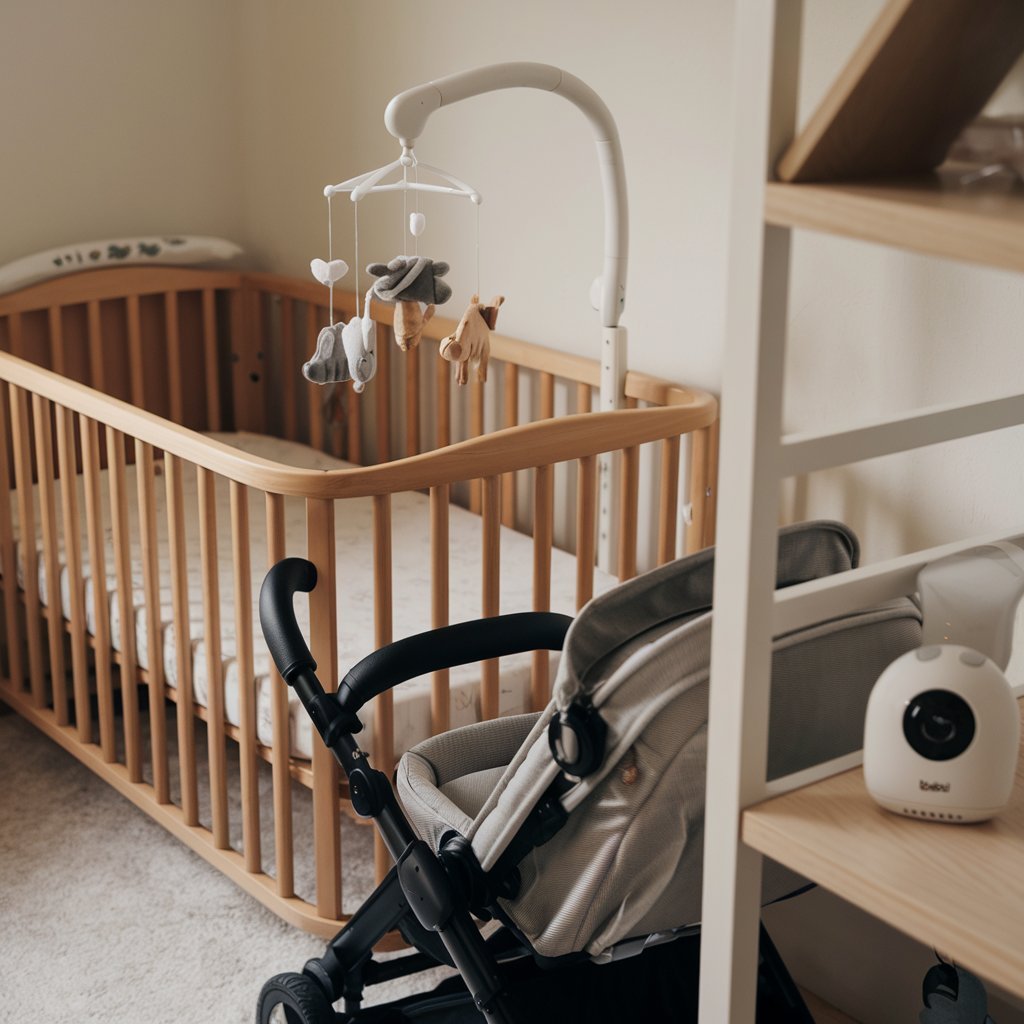Preparing for the arrival of your baby involves making important decisions about baby gear. With so many products available, it can be overwhelming for first-time parents to know which essentials to invest in. Among the most important purchases are strollers, cribs, and baby monitors. Each of these items plays a crucial role in your baby’s safety, comfort, and your peace of mind. In this blog post, we’ll guide you through the key considerations for choosing the best strollers, cribs, and baby monitors for your growing family.
Strollers: Choosing the Right Wheels for Your Baby
A stroller is an essential piece of baby gear that you’ll likely use every day for years. Whether you’re going for a walk in the park, running errands, or traveling, having the right stroller can make all the difference. Here’s what to consider when researching strollers.
Types of Strollers
There are many types of strollers to choose from, each designed to meet specific needs. Some of the most common types include:
- Full-Size Strollers: These are durable, long-lasting, and often include features like a reclining seat, a large canopy, and storage space. They can be used from infancy through toddlerhood, making them a versatile choice.
- Lightweight Strollers (Umbrella Strollers): These are compact and easy to maneuver, making them ideal for quick trips or travel. However, they may lack the durability and comfort of full-size models.
- Jogging Strollers: If you’re an active parent who enjoys running or walking on rough terrain, a jogging stroller with a sturdy frame and large wheels can provide a smoother ride for your baby.
- Travel System Strollers: These strollers come with a car seat that can snap directly into the stroller. Travel systems are convenient for parents who want an all-in-one solution for transportation.
- Double or Triple Strollers: For parents of twins or multiples, or those with close-in-age siblings, double or triple strollers allow you to transport multiple children at once.
Key Features to Look For
When selecting a stroller, here are some essential features to consider:
- Safety: Look for strollers with a five-point harness, a strong frame, and a reliable braking system.
- Maneuverability: Test the stroller to see how easily it turns and handles. Swiveling front wheels can make it easier to maneuver in tight spaces.
- Comfort: Ensure the stroller has padded seats and adjustable recline positions to keep your baby comfortable.
- Portability: If you plan on traveling often, choose a stroller that’s lightweight and folds compactly for easy storage in your car or home.
- Storage: Strollers with ample storage space underneath the seat can be helpful for carrying diaper bags, toys, or groceries.
Budget Considerations
Strollers can vary greatly in price, from budget-friendly models to high-end luxury designs. When deciding on a stroller, think about your lifestyle and how often you’ll use it. If you’re looking for a long-term investment, it may be worth spending a bit more on a durable, feature-rich model. However, if you only need a stroller for occasional use, a simpler, more affordable option may suffice.


Cribs: Ensuring a Safe and Comfortable Sleeping Environment
Your baby will spend many hours sleeping in their crib, so it’s essential to choose one that’s safe, comfortable, and meets your family’s needs. Here’s what to keep in mind when researching cribs.
Types of Cribs
There are several types of cribs to choose from:
- Standard Cribs: These are the most common type of crib, designed to provide a safe, sturdy sleeping space. They come in a range of styles and finishes to match your nursery decor.
- Convertible Cribs: These cribs can convert into toddler beds and even full-size beds as your child grows. While they are more expensive upfront, convertible cribs can save money in the long run by adapting to your child’s needs over time.
- Mini Cribs: If you have limited space, a mini crib can be a great solution. They are smaller than standard cribs but still provide a safe sleeping environment. Some mini cribs are portable and can be moved from room to room.
- Portable Cribs (Pack ‘n Play): These are foldable cribs that are easy to set up and transport, making them ideal for travel or temporary sleeping arrangements.
Safety Considerations
When it comes to cribs, safety is the top priority. Here are the key safety standards to look for:
- Sturdy Frame: Ensure the crib is made from durable materials and has a sturdy frame that won’t wobble.
- Proper Slat Spacing: Crib slats should be no more than 2 ⅜ inches apart to prevent your baby from getting stuck between them.
- Non-Toxic Finishes: Choose a crib that’s free from harmful chemicals and painted with non-toxic finishes.
- No Drop-Side Rails: Drop-side cribs, which have a side that lowers for easier access to the baby, have been banned in the U.S. due to safety concerns. Make sure the crib you choose complies with modern safety standards.
- Firm Mattress Fit: The crib mattress should fit snugly without any gaps between the mattress and the crib walls. This helps reduce the risk of suffocation or entrapment.
Additional Features
Some cribs come with additional features, such as adjustable mattress heights, which allow you to lower the mattress as your baby grows and becomes more mobile. This can prevent your baby from climbing out of the crib once they’re older.
Baby Monitors: Keeping an Eye on Your Baby 24/7
Baby monitors offer peace of mind by allowing you to keep an eye (and ear) on your baby, even when you’re in another room. With advancements in technology, baby monitors now come with a range of features that can help you stay connected with your little one.
Types of Baby Monitors
There are three main types of baby monitors to consider:
- Audio Monitors: These are the most basic type of baby monitor, transmitting sound from your baby’s room to a receiver. While they don’t provide video, audio monitors can be a more affordable option and still allow you to hear when your baby is crying or stirring.
- Video Monitors: Video monitors allow you to both see and hear your baby in real-time. Most video monitors come with a camera that you can place in the baby’s room and a handheld or smartphone-compatible display for viewing.
- Smart Monitors: Smart monitors take baby monitoring to the next level by including additional features such as breathing sensors, temperature monitors, and smartphone apps that allow you to check on your baby from anywhere.
Key Features to Consider
When researching baby monitors, consider the following features:
- Range: Ensure the monitor has a sufficient range to cover the distance between your baby’s room and where you’ll be. Some monitors also offer Wi-Fi connectivity for unlimited range via smartphone apps.
- Two-Way Audio: Two-way audio allows you to talk to your baby through the monitor, which can be soothing for them during naps or nighttime.
- Night Vision: For video monitors, night vision is a critical feature that allows you to see your baby in low-light conditions.
- Battery Life: Look for a monitor with a long battery life, especially if you plan to use it overnight or throughout the day.
- Breathing and Movement Sensors: Some smart monitors come equipped with sensors that can track your baby’s breathing and movement patterns, alerting you to any abnormalities. While these features can provide extra peace of mind, they aren’t always necessary for all parents.
Privacy and Security
If you choose a monitor with Wi-Fi capabilities, it’s important to consider privacy and security. Look for models with encrypted connections to protect against hacking, and always keep the monitor’s software updated to ensure the highest level of security.
Conclusion
Selecting the right baby gear is one of the most important aspects of preparing for your baby’s arrival. Strollers, cribs, and baby monitors are key investments that will support your baby’s safety, comfort, and your overall peace of mind. When researching these products, always prioritize safety features, durability, and how well they fit into your lifestyle.
By thoroughly researching and choosing wisely, you can ensure that you’re well-prepared for your baby’s arrival, setting the stage for a safe and comfortable experience for both you and your little one.


